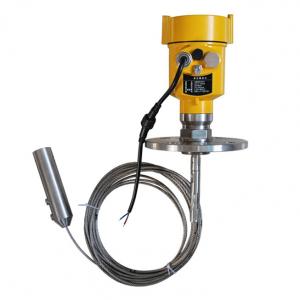
Add to Cart
Flange Thread Installation 15m Guided Wave Radar Level Transmitter
Selection principle
Guided wave radar can only measure powder for solids, because guided wave radar is contact type, the antenna (how long the cable is and how far) cannot measure blocks and particles (easy to break the cable), and because of the side pull of the solid, the guided wave radar The cable antenna must be selected for measuring powder, and the rod antenna is relatively easy to fall off.
| With DN100 flange | Maximum range 10m |
| With DN150 flange | Maximum range 15m |
| With DN200 flange | Maximum range 20m |
Selection and Installation of Guided Wave Radar
1.All jars with agitation cannot be measured directly by using guided wave radar. Install the waveguide or bypass tube, the radar is installed inside the tube to measure and install a bracket

2. Guided wave radar can penetrate about 20cm of foam, thicker foam cannot Guaranteed effect
3. Guided wave radar is suitable for slightly crystalline working conditions. Enhanced resistance to crystallization or coagulation



Configuration of flange
1. HKD701 radar standard minimum matching flange is DN50,
2. Flat welding is compatible with DN40 flange,
3. Special type, can be matched with DN20 flange by extension sensor.
4. HKD701 is made of metal for the tank top and can be screwed.
According to different measurement principles, radar level gauges can be divided into two types. It is a radar level gauge that controls the liquid level, and its accuracy is generally about 10mm; the other is a radar level gauge, which is used for precise measurement and settlement, with an accuracy of 1mm. Structurally, it is divided into rod antenna, horn antenna and cable antenna, debugging, installing and using the analog signal output by the radar level gauge. The digital signal is superimposed on it by 4~20mADC to realize the compatibility of analog signal and digital signal, conforming to HART protocol. It can provide users with more attractive solutions, especially suitable for large fluctuations, condensation, suspension, viscous slurries, dirty media, and corrosive liquid level measurement. It has a continuous frequency self-calibration function to ensure stable measurement accuracy; it uses HART protocol for digital communication, and uses communication equipment or portable handheld devices to process liquid level variables; the output signal is an analog signal and a HART digital signal superimposed. Using the 4-20mAhar manual operator, the output signal can be divided into liquid level, calculated volume or standard volume; all configuration information and programs are stored in non-erasable memory. When the power is interrupted, all data can be restored; the frequency is continuously self-calibrated to ensure the accuracy of the level gauge.